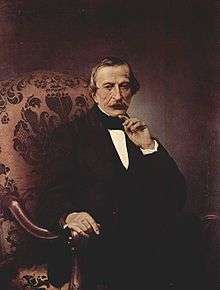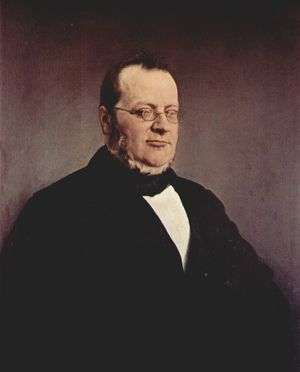Historical Right
Historical Right Destra storica | |
|---|---|
| Leaders | |
| Founded | 1849 |
| Dissolved | 1913 |
| Merged into | Liberal Union |
| Ideology |
Conservatism[1][2] Classical liberalism[3][4] Liberal conservatism[5][6][7] Monarchism[8] |
| Political position | Right-wing |
The Right group (Italian: Destra), later called Historical Right (Italian: Destra storica) by historians to distinguish it from the right-wing groups of the 20th century, was an Italian parliamentary group during the second half of the 19th century.[9] Since 1876, the Historical Right constituted the "Constitutional opposition" toward the left governments.[10] Since 1882, its members were usually labeled as Constitutionals or Liberal-Conservatives,[11] especially during the leadership of Rudinì and Sonnino.[5][12]
The Right was represented the interests of the Northern bourgeoisie and the Southern aristocracy. Its members were mostly large landowners, industrialists and people related to the military. On economy, the Right supported free trade and laissez-faire while on social issues it favoured a strong central government, obligatory conscription and during the Cavour's era the secular Law of Guarantees, causing Pope Pius IX's Non Expedit.[13] In foreign relations, their goal was the unification of Italy, primarily searching an alliance with the British Empire and the French Empire, but sometimes also with the German Empire against Austria.[14]
History
Origins
The origins of the Historical Right are in the right-wing faction of the Sardinian Parliament, established in 1849. The Right was at the time led by Massimo d'Azeglio, who was also a representative of the moderate movement that tried to unify Italy as a federation of states.[15] As the Right dominated the Parliament, D'Azeglio was appointed as Prime Minister of Sardinia by King Victor Emmanuel II. However, there were tensions inside the group, caused by D'Azeglio assertiveness towards the Catholic Church and the King.[16][17] The tensions caused the group to split into two separate factions:
- The "Conservatives", led by D'Azeglio, Luigi Cibrario, General La Marmora and Carlo Bon Compagni, who supported compromises with the Church and a slow Italian unification;
- The "Liberals", led by Cavour, Luigi Carlo Farini and Giovanni Galvagno, who supported the expropriation of the Church's goods, a lesser role of the King in government and French intervention in the Italian unification.
In May 1852, Cavour and his supporters left the Right group and moved toward the moderate Left, led by Urbano Rattazzi.[18] The duo Rattazzi-Cavour made an alliance (pejoratively called "a marriage"),[19] forming a big centrist group called Liberal Union. D'Azeglio was forced to resign in November 1852, and Cavour was appointed by the King as the new Prime Minister, ending the Sardinian phase of the Right.
Unification and governments
In 1861, Italy was united as a Kingdom under the House of Savoy. Cavour, who was Prime Minister of Sardinia since November 1852, with brief interructions, became the first Prime Minister of Italy. During the first year since unification, Cavour became more conservative as many radicals and republicans refused to recognize the new government, but instead recognize the Southern Army led by Giuseppe Garibaldi. Fearing a democratic revolution, Cavour became near to the new Right group in the Italian Parliament, led it until his premature death in June 1861. The Cavourian policies were partially continued by his successor, aligned with the Right group, like Luigi Farini, Bettino Ricasoli and Marco Minghetti. Since 1861, the Right's government pursued a policy of balanced budget,[20] maintained with austerity and high taxation. Like the taxations, especially the tax on grains, were unpopular among the rural and middle classes, the Right progressively lost its support. With that, the Right was split into two factions: the "original" Northern liberals, who supported taxation, and "new arrived" Southern conservatives, who opposed the modernization and taxation.[21]
Since 1870s, in a time of rising tensions inside the right governments, the group split into different factions for goals and territorial composition:[22]
- "Emilian clique", led by Marco Minghetti,[23] representing Emilian parochialism, supporting protectionism, paternalistic conservatism and alignment with Germany[24]
- "Piedmontese clique", led by Giovanni Lanza,[25] representing Piedmontese parochialism, supporting liberism and a moderate Francophile foreign policy[26]
- "Tuscan clique", led by Ubaldino Peruzzi,[27] representing Tuscan parochialism, favourable to liberism and modernization. Hostile to Minghetti but vague toward the Left[28]
- "Lombardian clique", led by Cesare Correnti,[29] representing the Lombardian parochialism, along with centrists and secularists, favourables to the cooperation with the Left.[28]
On 25 March 1876, Prime Minister Marco Minghetti was forced to resign after the so-called "Parliamentary Revolution": the Left, together dissident members from the Right, put the government in minority on the tax on grains' question, who damaged rural economy.[30] Ironically, many Right politicians who sided now with Left were from North. Since this moment, the Right fell in opposition, and Agostino Depretis, leader of the Left, was appointed as new Prime Minister.
The "Constitutional opposition"
After the fall of Minghetti, the Right progressively disbanded. On 8 October 1882, some weeks before the general elections, Depretis proclaim that anyone who will be "transform" into a progressive will be accepted in his government, and surprisingly Minghetti agree with that, causing the merge of the rest of the Right into the Left.[31] After this event, the rest of the anti-compromise Right was called "Liberal Constitutional Party" or "Constitutional opposition",[32] led by formers Finance Minister Quintino Sella and Interior Minister Antonio Starabba, Marquess of Rudinì. The PLC weren't a structured and organized party, but simply a coalition of both Northern and Southern conservatives, like Sidney Sonnino, Luigi Luzzatti and Pasquale Villari, who rejected opportunism and Depretis' protectionist policy.
After 10 years in opposition, the Constitutionals gain the majority thanks to an agreement with dissident Left Giovanni Nicotera and radical Felice Cavallotti, and Rudinì was charged to form a new government in substitution of Francesco Crispi. During his short government, overthrown after 1 year, Rudinì worked to reduce to public expenditure, limit the rising imperialist sentiment and keep Italy aligned with Triple Alliance.[33] Rudinì was recalled in office after the political fall of Crispi, followed the defeat in First Italo-Ethiopian War. During this second term, Rudinì worked to repress the Sicilian Fasci, a powerful rising socialist protest in Sicily, but also the nationalist groups. After 2 years, Rudinì was ousted from office after his unpopular cease of Kassala to the United Kingdom. Also in Constitutionals politicians like Luzzatti and Sonnino later formed their own governments, they were short and weakened by the newborn Italian Socialist Party and the first organized parties. The awareness of that forced the Constitutionals to join in the Liberal Union, a political alliance between all liberal politicians, many once a time opposed between them.[34]
Electoral results
| Chamber of Deputies | ||||||
| Election year | # of overall votes |
% of overall vote |
# of overall seats won |
+/– | Leader | |
|---|---|---|---|---|---|---|
| 1861 | 110,400 (#1) | 46.1 | 342 / 443 |
|||
| 1865 | unknown (#1) | 41.2 | 183 / 443 |
|||
| 1867 | 84,685 (#2) | 39.2 | 151 / 493 |
|||
| 1870 | 110,525 (#1) | 37.2 | 233 / 508 |
|||
| 1874 | 156,784 (#1) | 53.6 | 276 / 508 |
|||
| 1876 | 97,726 (#2) | 28.2 | 94 / 508 |
|||
| 1880 | 135,797 (#2) | 37.9 | 171 / 508 |
|||
| 1882 | unknown (#2) | 28.9 | 147 / 508 |
|||
| 1886 | unknown (#2) | 27.9 | 145 / 508 |
|||
| 1890 | unknown (#2) | 9.4 | 48 / 508 |
|||
| 1892 | unknown (#2) | 18.3 | 93 / 508 |
|||
| 1895 | 263,315 (#2) | 21.6 | 104 / 508 |
|||
| 1897 | unknown (#2) | 19.4 | 99 / 508 |
|||
| 1900 | 271,698 (#2) | 21.4 | 116 / 508 |
|||
| 1904 | 212,584 (#3) | 13.9 | 76 / 508 |
|||
| 1909 | 108,029 (#4) | 5.9 | 44 / 508 |
|||
References
- ↑ Gramsci, Antonio (1966). Gramsci Institute, ed. Studi storici. p. 703.
- ↑ Campanelli, Giuseppe; Carducci, Michele; Tondi Della Mura, Vincenzo; Loiodice, Isabella (2 December 2016). Giappichelli, ed. Lineamenti di diritto costituzionale della regione Puglia. p. 188.
- ↑ Baglioni, Guido (1973). L'Ideologia della borghesia industriale nell'Italia liberale. Einaudi. p. 191.
- ↑ Treccani, ed. (2010). "Destra storica italiana". Dizionario di Storia.
- 1 2 Mario Belardinelli (1976). ELIA, ed. Un esperimento liberal-conservatore: i governi di Rudinì (1896-1898).
- ↑ Umberto Gentiloni Silveri (2000). Stadium, ed. Conservatori senza partito. Un tentativo fallito nell'Italia giolittiana.
- ↑ Di Mauro, Luca. "La Destra storica". Oilproject.
- ↑ Gentile, Emilio (1982). Laterza, ed. Il mito dello Stato nuovo: Dal radicalismo nazionale al fascismo.
- ↑ Herb, Guntram H.; Kaplan, David H. Nations and Nationalism: A Global Historical Overview [4 volumes]. ABC-CLIO. ISBN 9781851099085.
- ↑ Pirett (October 1999). Una voce per l'Opposizione Costituzionale di Sua Maestà: Alle origini del "Giornale d'Italia" (in Italian). Contemporanea. pp. 699–712.
- ↑ Giovanni Battista Cuniglio (1896). A. Fina, ed. L'Italia liberale in fin di secolo: trattato politico di un liberale-conservatore. p. 156.
- ↑ Emilio Gentile (2003). "1. Il governo del generale Pelloux". In Laterza. Le origini dell'Italia contemporanea: L'età giolittiana.
- ↑ Montanelli, Indro (1977). Rizzoli, ed. Storia d'Italia: Gli anni della destra (1861-1876), vol. 32.
- ↑ Sarti, Roland (2009). "The Politics of the Liberal State (1861-1901)". In Infobase Publishing. Italy: A Reference Guide from the Renaissance to the Present.
- ↑ "Partito Moderato". Encilopedia Treccani.
- ↑ Romeo, Vita di Cavour, Bari, 2004, p. 213.
- ↑ Hearder, Cavour, Bari, 2000, p. 74.
- ↑ Romeo, Vita di Cavour, Bari, 2004, p. 213.
- ↑ Cavour (1865). "Discorsi parlamentari del conte Camillo di Cavour". Chamber of Deputies of Italy. p. 355. Retrieved 25 May 2014.
- ↑ XII/elenco
- ↑ Indro Montanelli (1977). Storia d'Italia: Gli anni della destra, (1861-1876). vol. 32 (in Italian). Rizzoli.
- ↑ Merlini, Stefano; Tarli Barbieri, Giovanni (11 January 2017). Giappichelli, ed. Il governo parlamentare in Italia. p. 34.
- ↑ Gherardi, Raffaella (2010). Treccani, ed. "Marco Minghetti". Dizionario Biografico degli Italiani. 74.
- ↑ Luzzatti, Luigi (2006). Cosimo, Inc, ed. God in Freedom: Studies in the Relations Between Church and State. p. 420.
- ↑ Montaldo, Silvano (2004). Treccani, ed. "Giovanni Lanza". Dizionario Biografico degli Italiani. 63.
- ↑ Tavallini, Enrico (1887). L. Roux & Co., ed. La vita e i tempi di Giovanni Lanza, vol. 2.
- ↑ Manfredi, Marco (2015). Treccani, ed. "Ubaldino Peruzzi". Dizionario Biografico degli Italiani. 82.
- 1 2 Leoni, Francesco (2001). Guida, ed. Storia dei partiti politici italiani. p. 117.
- ↑ Ambrosoli, Luigi (1983). Treccani, ed. "Cesare Correnti". Dizionario Biografico degli Italiani. 3.
- ↑ "Destra storica italiana" (in Italian). Treccani. 2010.
- ↑ Fulvio Cammarano (2011). Storia dell'Italia liberale. Laterza. ISBN 9788842095996.
- ↑ La Stampa historical archive.
- ↑ "Antonio Starrabba marchese di Rudinì". Treccani.
- ↑ Francesco Leoni (2001). Storia dei partiti politici italiani (in Italian). Guida Editori. p. 386.


